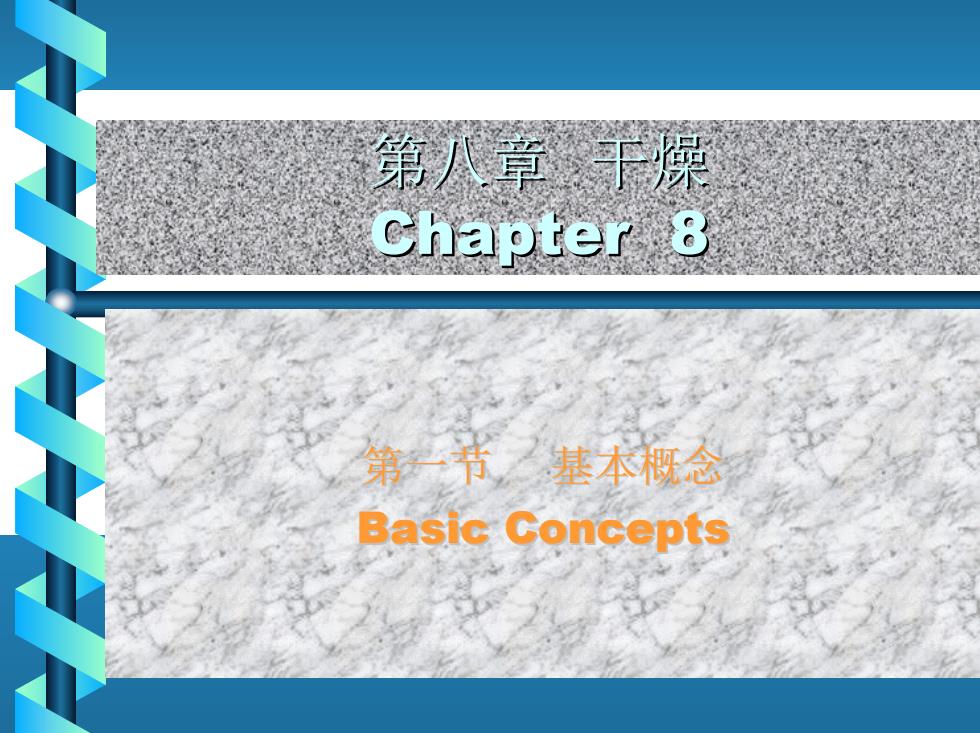
第八章 干燥 Chapter 8 Chapter 8 第一节 基本概念 Basic Concepts Basic Concepts
第八章 干燥 Chapter 8 Chapter 8 第一节 基本概念 Basic Concepts Basic Concepts
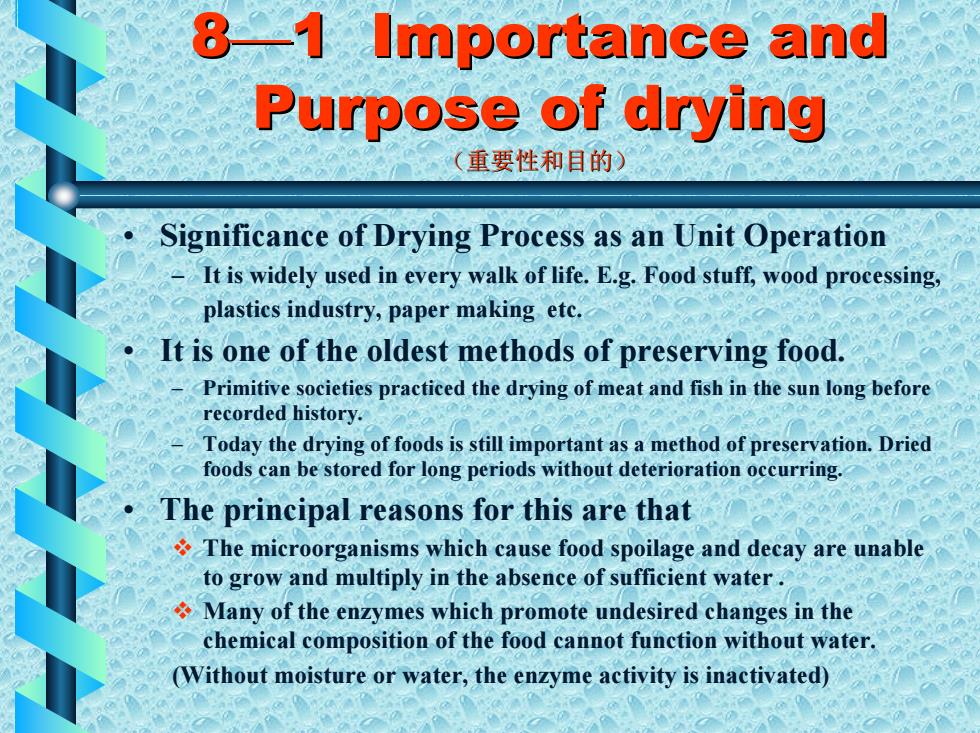
8—1 Importance and 1 Importance and Purpose of drying Purpose of drying (重要性和目的) • Significance of Drying Process as an Unit Operation – It is widely used in every walk of life. E.g. Food stuff, wood processing, plastics industry, paper making etc. • It is one of the oldest methods of preserving food. – Primitive societies practiced the drying of meat and fish in the sun long before recorded history. – Today the drying of foods is still important as a method of preservation. Dried foods can be stored for long periods without deterioration occurring. • The principal reasons for this are that The microorganisms which cause food spoilage and decay are unable to grow and multiply in the absence of sufficient water . Many of the enzymes which promote undesired changes in the chemical composition of the food cannot function without water. (Without moisture or water, the enzyme activity is inactivated)
8—1 Importance and 1 Importance and Purpose of drying Purpose of drying (重要性和目的) • Significance of Drying Process as an Unit Operation – It is widely used in every walk of life. E.g. Food stuff, wood processing, plastics industry, paper making etc. • It is one of the oldest methods of preserving food. – Primitive societies practiced the drying of meat and fish in the sun long before recorded history. – Today the drying of foods is still important as a method of preservation. Dried foods can be stored for long periods without deterioration occurring. • The principal reasons for this are that The microorganisms which cause food spoilage and decay are unable to grow and multiply in the absence of sufficient water . Many of the enzymes which promote undesired changes in the chemical composition of the food cannot function without water. (Without moisture or water, the enzyme activity is inactivated)

The Purpose of Drying The Purpose of Drying • Easy for preservation or store Easy for preservation or store – Drying makes food or raw food materials have long Drying makes food or raw food materials have long shelf life. ( in terms of microorganism and enzyme shelf life. ( in terms of microorganism and enzyme action). action). – Need small space of storehouse Need small space of storehouse • Convenient for transportation Convenient for transportation – Weight and volume are greatly reduced,improves Weight and volume are greatly reduced,improves significantly the efficiency of transportation In terms significantly the efficiency of transportation In terms of loading and unloading of loading and unloading • Convenient for consumer use Convenient for consumer use – E.g. milk powder,dried vegetables etc. E.g. milk powder,dried vegetables etc
The Purpose of Drying The Purpose of Drying • Easy for preservation or store Easy for preservation or store – Drying makes food or raw food materials have long Drying makes food or raw food materials have long shelf life. ( in terms of microorganism and enzyme shelf life. ( in terms of microorganism and enzyme action). action). – Need small space of storehouse Need small space of storehouse • Convenient for transportation Convenient for transportation – Weight and volume are greatly reduced,improves Weight and volume are greatly reduced,improves significantly the efficiency of transportation In terms significantly the efficiency of transportation In terms of loading and unloading of loading and unloading • Convenient for consumer use Convenient for consumer use – E.g. milk powder,dried vegetables etc. E.g. milk powder,dried vegetables etc
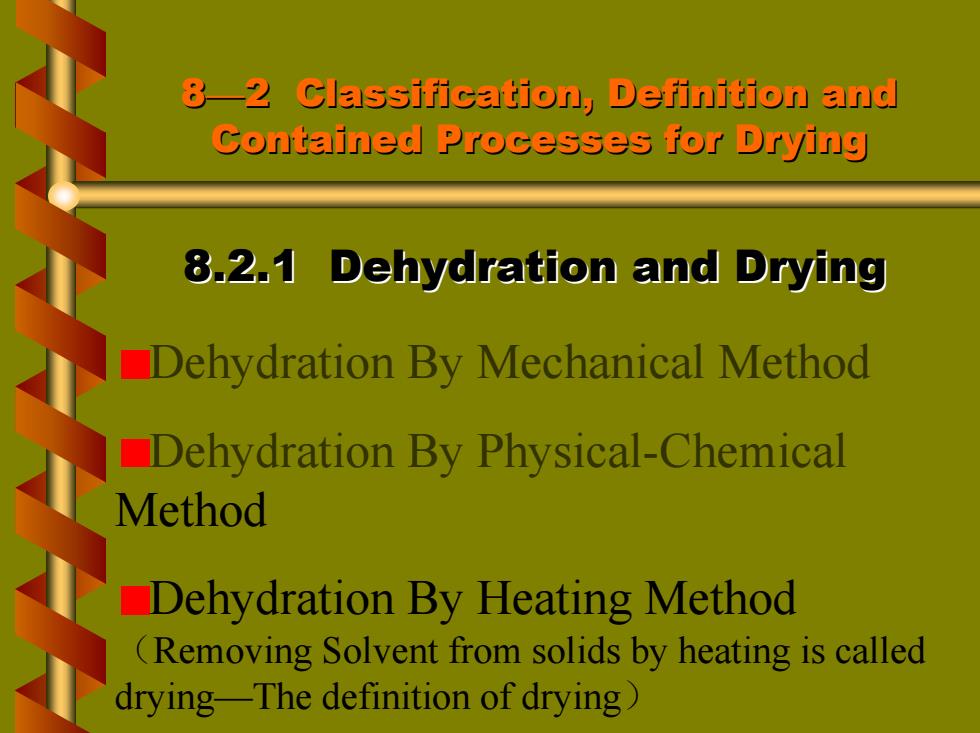
8—2 Classification, Definition and 2 Classification, Definition and Contained Processes for Drying Contained Processes for Drying 8.2.1 Dehydration and Drying 8.2.1 Dehydration and Drying Dehydration By Mechanical Method Dehydration By Physical-Chemical Method Dehydration By Heating Method (Removing Solvent from solids by heating is called drying—The definition of drying)
8—2 Classification, Definition and 2 Classification, Definition and Contained Processes for Drying Contained Processes for Drying 8.2.1 Dehydration and Drying 8.2.1 Dehydration and Drying Dehydration By Mechanical Method Dehydration By Physical-Chemical Method Dehydration By Heating Method (Removing Solvent from solids by heating is called drying—The definition of drying)
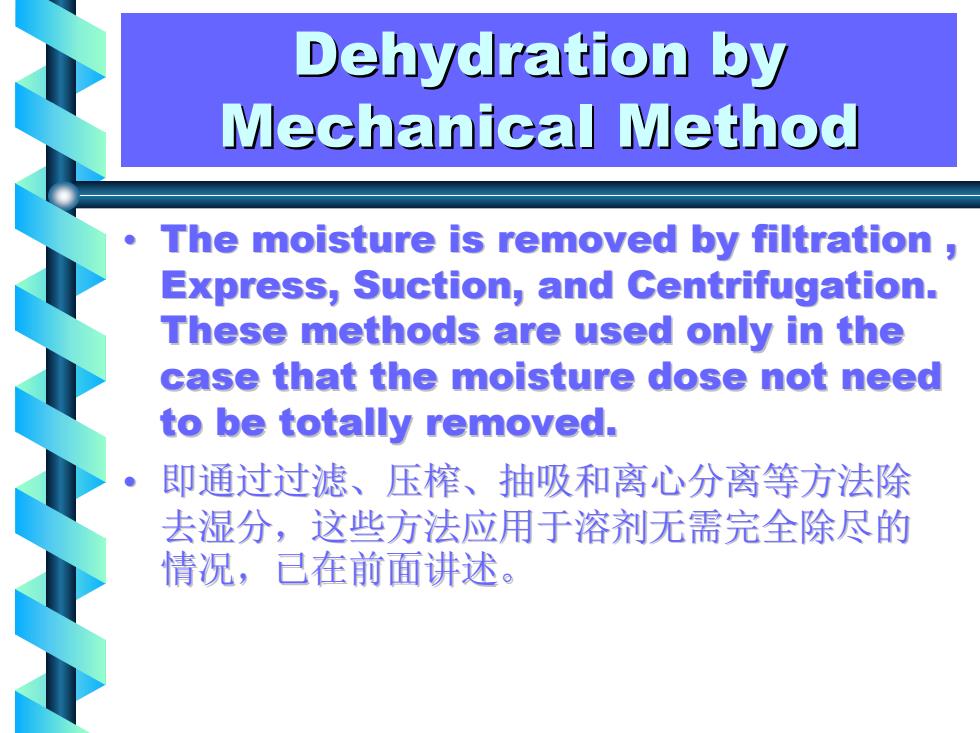
Dehydration by Dehydration by Mechanical Method Mechanical Method • The moisture is removed by filtration , The moisture is removed by filtration , Express, Suction, and Centrifugation. Express, Suction, and Centrifugation. These methods are used only in the These methods are used only in the case that the moisture dose not need case that the moisture dose not need to be totally removed. to be totally removed. • 即通过过滤、压榨、抽吸 即通过过滤、压榨、抽吸 和离心分离等方法除 离心分离等方法除 去湿分,这些方法应用于溶剂无需完全除尽 去湿分,这些方法应用于溶剂无需完全除尽 的 情况,已在前面讲述。 情况,已在前面讲述
Dehydration by Dehydration by Mechanical Method Mechanical Method • The moisture is removed by filtration , The moisture is removed by filtration , Express, Suction, and Centrifugation. Express, Suction, and Centrifugation. These methods are used only in the These methods are used only in the case that the moisture dose not need case that the moisture dose not need to be totally removed. to be totally removed. • 即通过过滤、压榨、抽吸 即通过过滤、压榨、抽吸 和离心分离等方法除 离心分离等方法除 去湿分,这些方法应用于溶剂无需完全除尽 去湿分,这些方法应用于溶剂无需完全除尽 的 情况,已在前面讲述。 情况,已在前面讲述
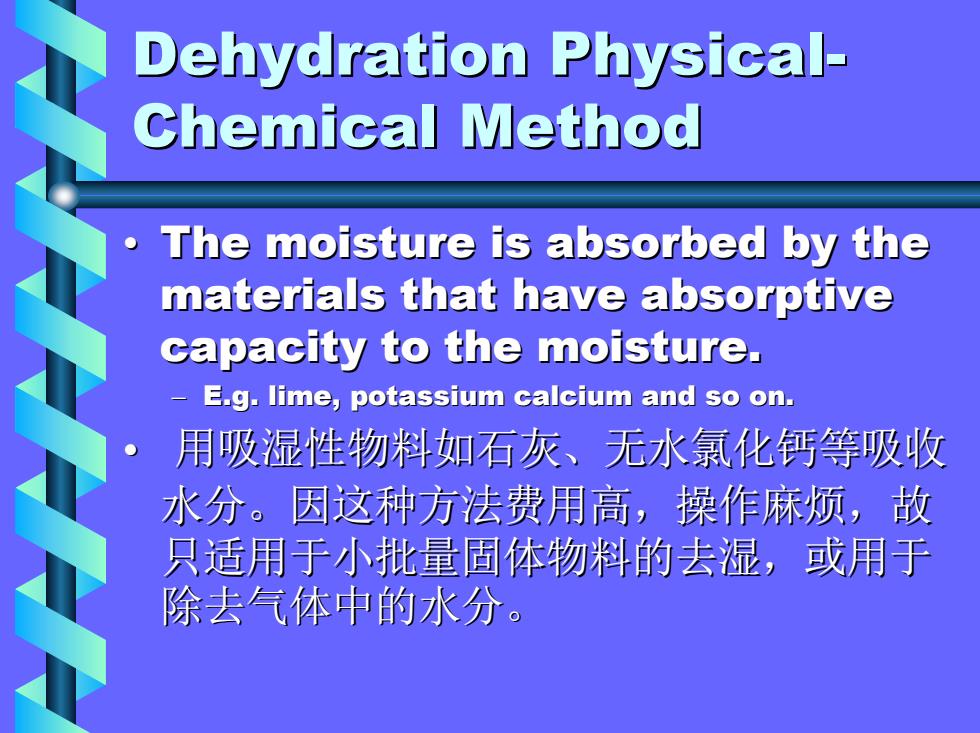
Dehydration Physical Dehydration Physical - Chemical Method Chemical Method • The moisture is absorbed by the The moisture is absorbed by the materials that have absorptive materials that have absorptive capacity to the moisture. capacity to the moisture. – E.g. li E.g. lime, potassium calcium and so on. me, potassium calcium and so on. • 用吸湿性物料如石灰、无水氯化钙等吸收 物料如石灰、无水氯化钙等吸收 水分。因这种方法费用高 水分。因这种方法费用高,操作麻烦,故 ,操作麻烦,故 只适用于小批量固体物料的 只适用于小批量固体物料的去湿,或用于 除去气体中的水分
Dehydration Physical Dehydration Physical - Chemical Method Chemical Method • The moisture is absorbed by the The moisture is absorbed by the materials that have absorptive materials that have absorptive capacity to the moisture. capacity to the moisture. – E.g. li E.g. lime, potassium calcium and so on. me, potassium calcium and so on. • 用吸湿性物料如石灰、无水氯化钙等吸收 物料如石灰、无水氯化钙等吸收 水分。因这种方法费用高 水分。因这种方法费用高,操作麻烦,故 ,操作麻烦,故 只适用于小批量固体物料的 只适用于小批量固体物料的去湿,或用于 除去气体中的水分
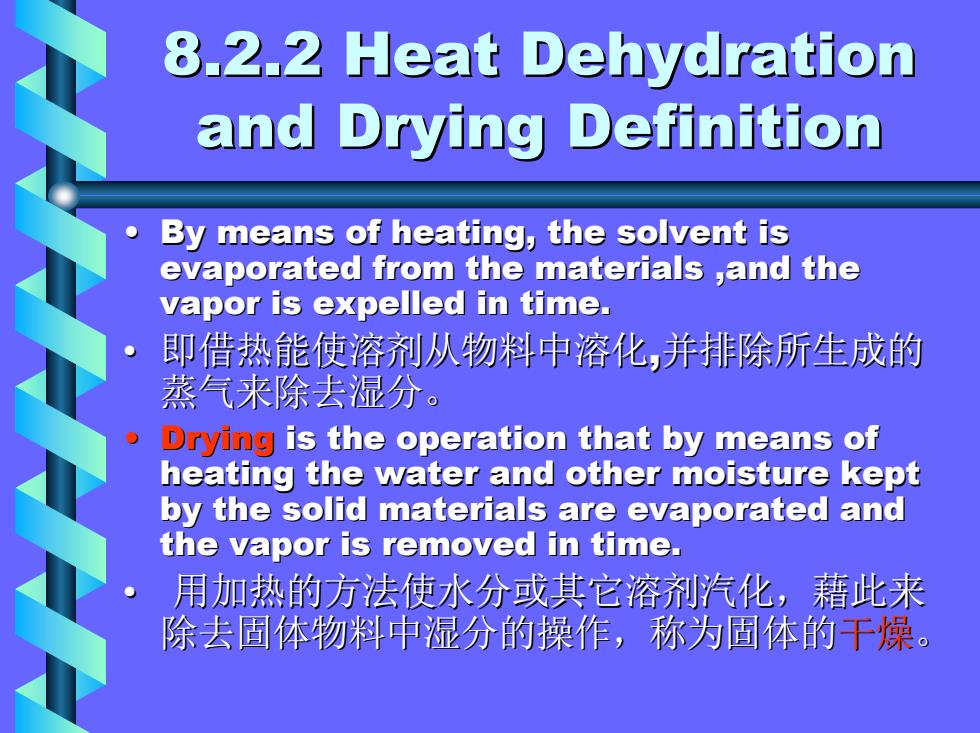
8.2.2 Heat Dehydration 8.2.2 Heat Dehydration and Drying Definition and Drying Definition • By means of heating, the solvent is By means of heating, the solvent is evaporated from the materials ,and the evaporated from the materials ,and the vapor is expelled in time. vapor is expelled in time. • 即借热能使溶剂从物料中溶化 即借热能使溶剂从物料中溶化 ,并排除所生成的 并排除所生成的 蒸气来除去湿分。 蒸气来除去湿分。 • Drying is the operation that by means of is the operation that by means of heating the water and other moisture kept heating the water and other moisture kept by the solid materials are evaporated and by the solid materials are evaporated and the vapor is removed in time. the vapor is removed in time. • 用 加热的 方 法使水分或其它溶剂汽化,藉 使水分或其它溶剂汽化,藉 此 来 除去固体物料中湿分 除去固体物料中湿分 的操作,称为固体 操作,称为固体 的干燥
8.2.2 Heat Dehydration 8.2.2 Heat Dehydration and Drying Definition and Drying Definition • By means of heating, the solvent is By means of heating, the solvent is evaporated from the materials ,and the evaporated from the materials ,and the vapor is expelled in time. vapor is expelled in time. • 即借热能使溶剂从物料中溶化 即借热能使溶剂从物料中溶化 ,并排除所生成的 并排除所生成的 蒸气来除去湿分。 蒸气来除去湿分。 • Drying is the operation that by means of is the operation that by means of heating the water and other moisture kept heating the water and other moisture kept by the solid materials are evaporated and by the solid materials are evaporated and the vapor is removed in time. the vapor is removed in time. • 用 加热的 方 法使水分或其它溶剂汽化,藉 使水分或其它溶剂汽化,藉 此 来 除去固体物料中湿分 除去固体物料中湿分 的操作,称为固体 操作,称为固体 的干燥

Ways of Classification Ways of Classification for Drying Process for Drying Process Classified by Pressure Classified by Pressure Atmospheric pressure drying Atmospheric pressure drying Vacuum Drying Vacuum Drying Classified by Operation Method Classified by Operation Method Batch drying Batch drying Continuous Drying Continuous Drying Classified by Mode of Heat Transfer Classified by Mode of Heat Transfer Conduction Conduction Convection Convection Radiation Radiation Dielectric drying Dielectric drying (高频干燥)
Ways of Classification Ways of Classification for Drying Process for Drying Process Classified by Pressure Classified by Pressure Atmospheric pressure drying Atmospheric pressure drying Vacuum Drying Vacuum Drying Classified by Operation Method Classified by Operation Method Batch drying Batch drying Continuous Drying Continuous Drying Classified by Mode of Heat Transfer Classified by Mode of Heat Transfer Conduction Conduction Convection Convection Radiation Radiation Dielectric drying Dielectric drying (高频干燥)
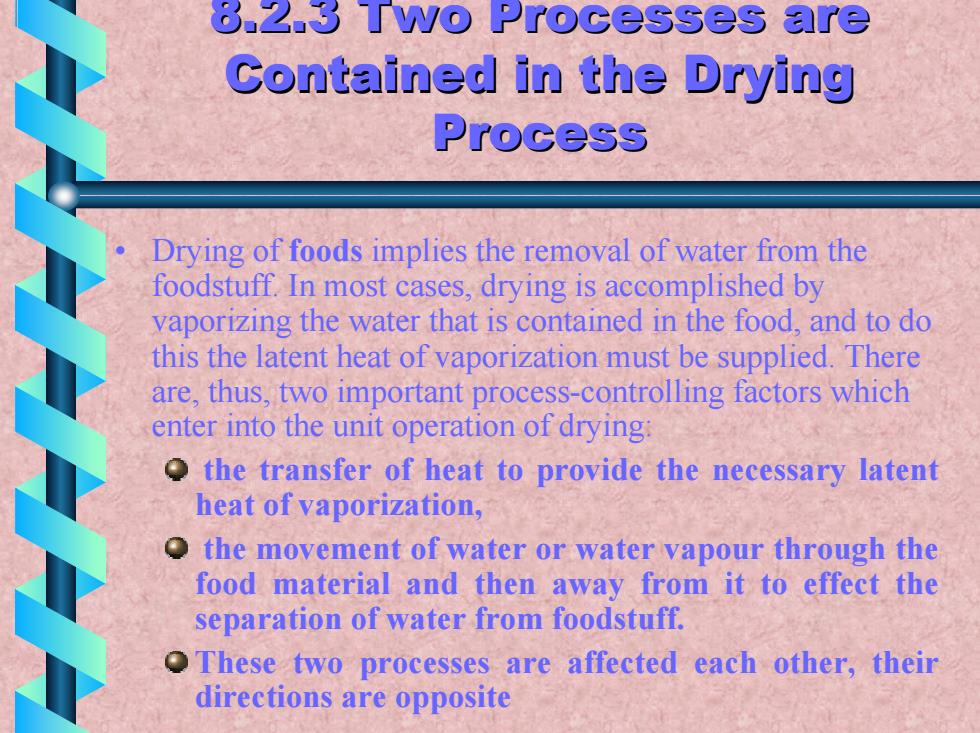
8.2.3 Two Processes are wo Processes are Contained in the Drying Contained in the Drying Process Process • Drying of foods implies the removal of water from the foodstuff. In most cases, drying is accomplished by vaporizing the water that is contained in the food, and to do this the latent heat of vaporization must be supplied. There are, thus, two important process-controlling factors which enter into the unit operation of drying: the transfer of heat to provide the necessary latent heat of vaporization, the movement of water or water vapour through the food material and then away from it to effect the separation of water from foodstuff. These two processes are affected each other, their directions are opposite
8.2.3 Two Processes are wo Processes are Contained in the Drying Contained in the Drying Process Process • Drying of foods implies the removal of water from the foodstuff. In most cases, drying is accomplished by vaporizing the water that is contained in the food, and to do this the latent heat of vaporization must be supplied. There are, thus, two important process-controlling factors which enter into the unit operation of drying: the transfer of heat to provide the necessary latent heat of vaporization, the movement of water or water vapour through the food material and then away from it to effect the separation of water from foodstuff. These two processes are affected each other, their directions are opposite
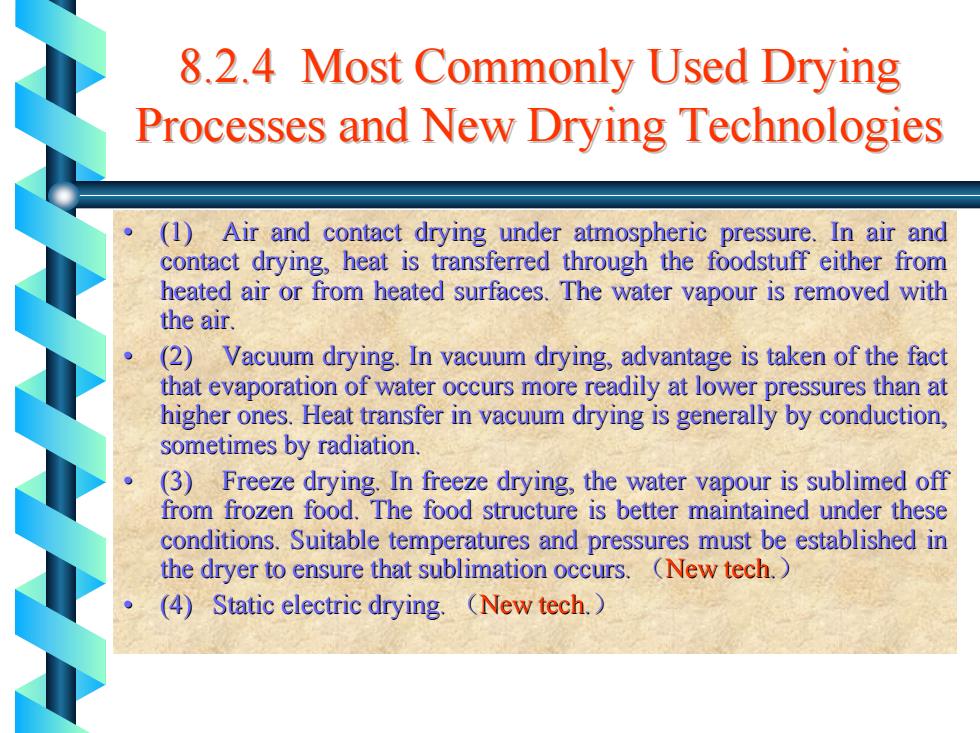
8.2.4 Most Commonly Used Drying 8.2.4 Most Commonly Used Drying Processes and New Drying Technologies Processes and New Drying Technologies • (1) Air and contact drying under atmospheric pressure. In air and contact drying under atmospheric pressure. In air and contact contact drying, heat is transf drying, heat is transferred through the foodstuff either erred through the foodstuff either from heated air or from heated surface heated air or from heated surfaces. The water vapour is s. The water vapour is removed removed with the air. the air. • (2) Vacuum drying. In vacuum drying, Vacuum drying. In vacuum drying, advantage is taken of the fac advantage is taken of the fact that evaporati that evaporation of water occurs on of water occurs more readily at lower readily at lower pressures pressures than at than at higher ones. Heat ones. Heat transfer transfer in vacuum dryi vacuum drying is generall ng is generally by cond y by conduction, uction, sometimes by radiati mes by radiation. • (3) Freeze drying. drying. In freeze drying, the water vapour is sublimed of In freeze drying, the water vapour is sublimed off from frozen food. The food struct from frozen food. The food structure is better maintained under ure is better maintained under these conditi conditions. Suitable temperatures and pressures must be establis ons. Suitable temperatures and pressures must be established in the dryer to ensure that sublimation occurs. the dryer to ensure that sublimation occurs. (New tech New tech.) • (4) Static electric drying. (4) Static electric drying. (New tech New tech.)
8.2.4 Most Commonly Used Drying 8.2.4 Most Commonly Used Drying Processes and New Drying Technologies Processes and New Drying Technologies • (1) Air and contact drying under atmospheric pressure. In air and contact drying under atmospheric pressure. In air and contact contact drying, heat is transf drying, heat is transferred through the foodstuff either erred through the foodstuff either from heated air or from heated surface heated air or from heated surfaces. The water vapour is s. The water vapour is removed removed with the air. the air. • (2) Vacuum drying. In vacuum drying, Vacuum drying. In vacuum drying, advantage is taken of the fac advantage is taken of the fact that evaporati that evaporation of water occurs on of water occurs more readily at lower readily at lower pressures pressures than at than at higher ones. Heat ones. Heat transfer transfer in vacuum dryi vacuum drying is generall ng is generally by cond y by conduction, uction, sometimes by radiati mes by radiation. • (3) Freeze drying. drying. In freeze drying, the water vapour is sublimed of In freeze drying, the water vapour is sublimed off from frozen food. The food struct from frozen food. The food structure is better maintained under ure is better maintained under these conditi conditions. Suitable temperatures and pressures must be establis ons. Suitable temperatures and pressures must be established in the dryer to ensure that sublimation occurs. the dryer to ensure that sublimation occurs. (New tech New tech.) • (4) Static electric drying. (4) Static electric drying. (New tech New tech.)